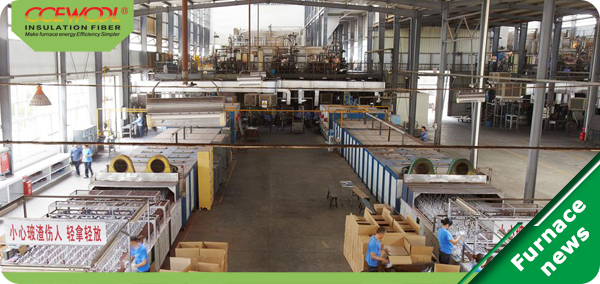
Oct. 28, 2016
The structure of the glass furnace is consists of L-type hanging wall, melting part, clip neck, cooling part including ear pool, annealing furnace, regenerator and other parts.

1. The choices of Arch
The arch (Including the arch angle) of glass melting furnace melting part and cooling part, these parts at 1600 degrees Celsius operating temperature, the refractories material in these parts should not only be able to withstand high temperatures, load deformation but also to withstand the effect of souring from alkali steam and its mixture. Therefore, as the top of the refractory material must have characteristics of high refractoriness, high loading deformation temperature and good creep resistance, and low thermal conductivity, high temperature refractory material can not pollute the glass, the material Bulk density should be smaller, high temperature strength.
High-performance high-quality CCEWOOL alumina fire bricks just have the characteristics below:
① High dimensional accuracy, the error is less than 1mm, easy to install;
② The same level of brick, porosity is low, 20% higher compressive strength;
③ Color uniformity, less black spots, low iron content, and long service life of 20%.
2. The choices of furnace wall
Contact with the glass metal
The direct contact between the melting part, the cooling part of the wall and the glass metal, subject by high temperature, chemical corrosion and flow caused by the glass metal cause the mechanical physical souring. The most important part of the refractory material is with good anti-corrosion properties of the glass mental liquid, while cannot pollute the glass. Domestic glass furnace masonry commonly used electric fused zirconia corundum bricks and α-β corundum bricks, β corundum brick.
The electric fused zirconia alumina fire bricks has excellent high temperature resistant and anti-vitreous performance, which obtain co-crystal of orthorhombic zircon and α-Al2O3 which is excellent in corrosion resistance which is impossible to obtain by sintered refractories. So it is very suitable for the glass furnace melting part. Α-β corundum bricks and β corundum bricks’ the main crystal phase is corundum, glass phase content is only 1% -2%, with good corrosion resistance, and compared with electric fused zirconia alumina fire bricks’ performance, because no ZrO2 crystal, the reaction layer viscosity is small, not very stable at high temperatures, so diffusion rate between the surface of brick and glass metal is relatively large, faster kiln lining damage.
However, when the furnace operation temperature is below 1350C, the corrosion resistance of α-β corundum brick and β corundum brick is better than electric fused zirconia alumina fire bricks. Therefore, α-β corundum bricks, β corundum bricks in the temperature below 1350 degrees Celsius, are the ideal refractory cooling parts.
Not in direct contact with the glass metal
Melting part and cooling part that is not direct contact with the glass metal (Also called the chest wall), this area is mainly affected by the effect of souring from alkali steam and its mixture. Depending on the different design, corundum material and silicon Brick are all available for selected; these two kinds of materials can meet the requirements. So tuckstons, straight brick often used in this area.
The above mentioned how to select CCEWOOL alumina fire bricks in Glass Furnace, hoping to help the kiln manufacturers and constructors.
